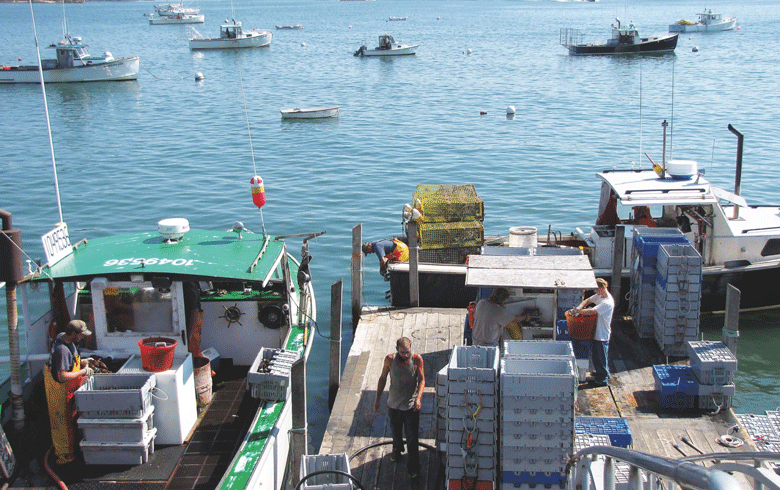Although there are several ongoing programs that monitor the status of the lobster population in Maine, no equivalent system exists to understand the status of the fishery itself, and of those who work within it.
In a new project led by Joshua Stoll, assistant professor of marine policy and fellow with the Senator George J. Mitchell Center for Sustainability Solutions at the University of Maine, researchers are investigating how the Maine lobster fishery is doing, and how it can adapt in a rapidly changing world. Partners in this research, which is also funded by the National Oceanographic and Atmospheric Administration (NOAA) Sea Grant’s American Lobster Initiative, include the Maine Lobstermen’s Association, Maine Center for Coastal Fisheries, and Maine Department of Marine Resources.
With a catch valued at just over $491 million in 2019, according to DMR data, the Maine lobster fishery is among the most valuable commercial fisheries in the U. S. As a central driver of the state’s economy through the fishery itself and associated economic activity, it supports thousands of jobs in coastal communities across the state.
Over the last three decades there have been three well-documented disruptions in the fishery…
The lobster fishery “is critical to our coastal communities for economic and cultural reasons,” says Kathleen Reardon, lead lobster biologist for DMR and a research collaborator. “It’s part of Maine’s identity.”
Yet the fishery also faces serious challenges related to climate change, trade and regulatory issues around the recovery of endangered right whales.
During the past 20 years or so, Maine has experienced an unprecedented increase in lobster abundance. The social and economic realities of lobster fishermen and fishing communities have not always been on the same trajectory, however.
For example, researchers note that over the last three decades there have been three well-documented disruptions in the fishery that have been widely described as “crises” by the industry. These crises were not triggered by declines in lobster abundance, but rather by sudden price changes caused by shifts in the global seafood economy.
Recognizing this pattern, lobstermen, scientists, and policymakers have worked to gain a better understanding of the social and economic resilience of the fishery.
“Developing metrics to monitor the impacts of social, environmental, and economic changes is critically important for the lobster industry to identify successful adaptation strategies,” notes Patrice McCarron, executive director of the Maine Lobstermen’s Association and a research collaborator. “The results will benefit lobstermen, coastal communities and policymakers.”
Because resilience can’t be measured directly, like water temperature or lobster size, assessing it requires identifying indicators that represent it and finding ways to capture the information those indicators provide. For example, one indicator might be the number of fishing trips made in a given time period—a shift up or down could signal a change in the profitability of the fishery.
Much of the research to date on resilience indicators uses more “static” data, such as from the U.S. Census, that doesn’t reflect what’s happening in a community—or a fishery—in current or recent time. One of the goals of this project is to integrate the use of real-time (or nearly so) data, which would help fishermen, communities, and resource managers plan and adapt more effectively.
The research is driven by needs identified by many stakeholders—fishermen, coastal communities, resource managers, and policymakers. Carla Guenther, chief scientist for the Maine Center for Coastal Fisheries in Stonington and a collaborator on the project, notes that input from and engagement with fishermen are especially crucial.
“This is what fishermen have been asking for,” Guenther says. “They’ve been highlighting the need for this for a long time.”
Learn more about this project and Josh Stoll’s work in community-supported fisheries on the Mitchell Center website: umaine.edu/mitchellcenter





